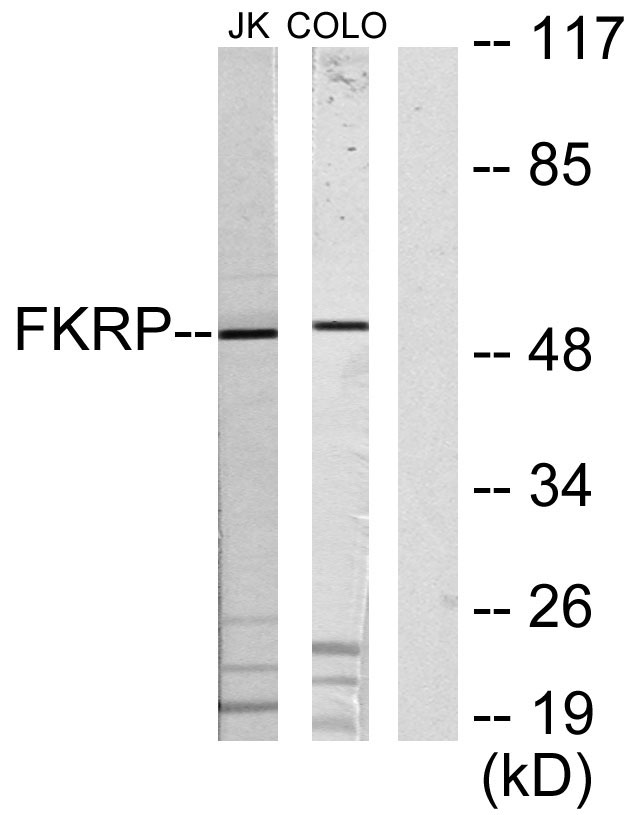产品名称
FKRP Rabbit Polyclonal Antibody
别名
FKRP; Fukutin-related protein
蛋白名称
Fukutin-related protein
存储缓冲液
Liquid in PBS containing 50% glycerol, 0.5% BSA and 0.02% New type preservative N.
Human Gene Link
http://www.ncbi.nlm.nih.gov/sites/entrez?db=gene&term=79147
Human Swissprot No.
Q9H9S5
Human Swissprot Link
http://www.uniprot.org/uniprotkb/Q9H9S5/entry
Mouse Gene Link
http://www.ncbi.nlm.nih.gov/sites/entrez?db=gene&term=243853
Mouse Swissprot No.
Q8CG64
Mouse Swissprot Link
http://www.uniprot.org/uniprot/Q8CG64
免疫原
The antiserum was produced against synthesized peptide derived from human FKRP. AA range:1-50
特异性
FKRP Polyclonal Antibody detects endogenous levels of FKRP protein.
稀释度
WB 1:500 - 1:2000. IF 1:200 - 1:1000. ELISA: 1:20000. Not yet tested in other applications.
宿主
Polyclonal, Rabbit,IgG
背景介绍
This gene encodes a protein which is targeted to the medial Golgi apparatus and is necessary for posttranslational modification of dystroglycan. Mutations in this gene have been associated with congenital muscular dystrophy, mental retardation, and cerebellar cysts. Several alternatively spliced transcript variants of this gene have been described, but the full-length nature of some of these variants has not been determined. [provided by RefSeq, Oct 2008],
组织表达
Expressed in the retina (at protein level) (PubMed:29416295). Expressed predominantly in skeletal muscle, placenta, and heart and relatively weakly in brain, lung, liver, kidney, and pancreas (PubMed:11592034).
细胞定位
Golgi apparatus membrane ; Single-pass type II membrane protein . Secreted . Cell membrane, sarcolemma . Rough endoplasmic reticulum . Cytoplasm . According to some studies the N-terminal hydrophobic domain is cleaved after translocation to the Golgi apparatus and the protein is secreted (PubMed:19900540). Localization at the cell membrane may require the presence of dystroglycan (By similarity). At the Golgi apparatus localizes to the middle-to-trans-cisternae, as assessed by MG160 colocalization. Detected in rough endoplasmic reticulum in myocytes (PubMed:17554798, PubMed:21886772). In general, mutants associated with severe clinical phenotypes are retained within the endoplasmic reticulum (PubMed:15213246). .
功能
disease:Defects in FKRP are the cause of congenital muscular dystrophy type 1C (MDC1C) [MIM:606612]. Congenital muscular dystrophies (CMD) are a heterogeneous group of autosomal recessive disorders characterized by hypotonia, muscle weakness, and joint contractures that present at birth or during the first 6 months of life and have dystrophic changes on skeletal muscle biopsy. Mental retardation with or without structural CNS changes may accompany some forms. MDC1C is a form of CMD with onset in the first weeks of life and a severe phenotype with inability to walk, muscle hypertrophy, marked elevation of serum creatine kinase, a secondary deficiency of laminin alpha2, and a marked reduction in alpha-dystroglycan expression. Only a subset of MDC1C patients have brain involvements.,disease:Defects in FKRP are the cause of limb-girdle muscular dystrophy type 2I (LGMD2I) [MIM:607155]. LGMD2I is an autosomal recessive disorder with age of onset ranging from childhood to adult life, and variable severity. Clinical features include proximal muscle weakness, waddling gait, calf hypertrophy, cardiomyopathy and respiratory insufficiency. A reduction of alpha-dystroglycan and laminin alpha-2 expression can be observed on skeletal muscle biopsy from LGMD2I patients.,disease:Defects in FKRP may be a cause of muscle-eye-brain disease (MEB) [MIM:253280]. MEB is an autosomal recessive disorder characterized by congenital muscular dystrophy, ocular abnormalities, cobblestone lissencephaly and cerebellar hypoplasia. MEB patients present severe congenital myopia, congenital glaucoma, pallor of the optic disks, retinal hypoplasia, mental retardation, hydrocephalus, abnormal electroencephalograms, generalized muscle weakness and myoclonic jerks.,disease:Defects in FKRP may be a cause of Walker-Warburg syndrome (WWS) [MIM:236670]; also known as hydrocephalus-agyria-retinal dysplasia or HARD syndrome. WWS is an autosomal recessive disorder characterized by cobblestone lissencephaly, hydrocephalus, agyria, retinal displasia, with or without encephalocele. It is often associated with congenital muscular dystrophy and usually lethal within the first few months of life.,function:Could be a transferase involved in the modification of glycan moieties of alpha-dystroglycan (DAG1).,online information:GlycoGene database,similarity:Belongs to the licD transferase family.,tissue specificity:Expressed predominantly in skeletal muscle, placenta, and heart and relatively weakly in brain, lung, liver kidney and pancreas.,
纯化
The antibody was affinity-purified from rabbit antiserum by affinity-chromatography using epitope-specific immunogen.

